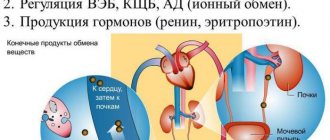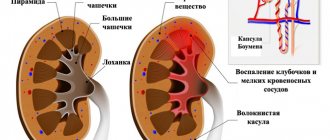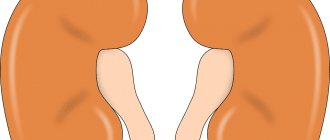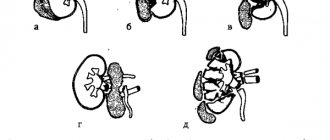If a person of any age begins to hurt their kidneys, they should definitely consult a doctor. Especially if a child complains of pain. Kidney fever in adults and children is an alarming sign that cannot be ignored, otherwise there is a risk not only to health, but also to life.
At the first signs of illness, you should understand what is causing it. The doctor will do this. Laboratory tests and ultrasound diagnostics are usually prescribed. Often, such a disease is caused by inflammatory pathologies, urolithiasis or neoplasms.
It is worth noting that if a bacterial infection is superimposed on the inflammation, the temperature from the kidneys does not drop when using the usual means to bring it down.
In addition to pain, patients complain of the following symptoms:
- headache;
- disturbance of well-being;
- nausea (sometimes vomiting).
Deterioration in general health occurs due to intoxication. In addition, the urinary system is of concern:
- pain and burning when urinating;
- pain in the lower abdomen;
- urine turns reddish.
If treatment is not started in a timely manner, renal failure develops, which can lead to irreversible consequences.
Pyelonephritis
Pyelonephritis is caused by pathogenic microorganisms. Pathogenic bacteria begin to secrete protein, leading to intoxication of the body. Elevated temperature is a reaction to the waste product of bacteria.
In acute pyelonephritis, signs of the disease appear a few days after the pathogens. Infection occurs with the blood flow through the ureter from the bladder cavity.
Signs of acute form:
- elevated temperature from 38 to 40°C;
- fever, chills with sweating at night;
- pain in the lower back;
- intoxication, nausea.
An increase in temperature, with acute pyelonephritis, is one of the types of body immunity. If the patient has a weakened immune defense, temperature values may fluctuate. Treatment of acute pyelonephritis takes two weeks, purulent pyelonephritis is treated for more than a month.
Chronic pyelonephritis is characterized by a low-grade fever of about 37°C. The patient may not be aware of the disease. It is necessary to correlate a number of factors and contact a medical facility.
Signs of chronic pyelonephritis:
- back pain that may not bother you;
- presence of slight temperature – 37 °C;
- the appearance of edema in the lower extremities;
- urine output with pain.
The chronic course of the pathology is dangerous; the manifestation of the clinical picture is a reason for examination.
What to do if your kidneys hurt?
Of course, you need to contact a specialist. However, treatment for a kidney problem cannot begin immediately as a diagnosis is needed first. Before making a diagnosis, you can slightly alleviate the condition with dry heat. This is the only measure that can be used in this case. This is easy to do: you need to wrap a warm scarf or handkerchief around your lower back. After 1-2 hours it will become a little easier. However, relief of the condition should not lead to refusal to go to the doctor.
In cases where the kidneys hurt and the temperature rises, you need to consult a doctor or call an ambulance. These manifestations may be symptoms of a serious illness.
tvoyaybolit.ru
Glomerulonephritis
It is characterized by damage to the renal glomeruli (glomeruli) by an allergic or infectious pathogen. Streptococcal disease (scarlet fever, chronic tonsillitis, tonsillitis) can initiate glomerulonephritis. Such interference disrupts the filtration work of the kidneys and makes changes in the functioning of the body. Diffuse glomerulonephritis is characterized by the following symptoms:
- temperature increase;
- kidney pain;
- intoxication of the body;
- change in urine color to dark;
- blood pressure increases;
- swelling syndrome;
- decreased urine output.
With this pathology, the pain syndrome does not cause discomfort to the patient. The patient may not complain of pain in the lumbar region. An increase in temperature is not a sign of glomerulonephritis; an increase in temperature means the presence of an infection. When diagnosing, evaluate the results of a urine test.
How are sick kidneys treated during fever?
Since most often the temperature and kidney pain occur with pyelonephritis, namely in an acute form, the question arises of what to do with this illness.
Such an inflammatory process should be treated comprehensively:
- Antibiotics are prescribed during acute illness without fail. Typically attributed to Amoxicillin, which has a wide range of properties. It has different names and is used in the treatment of various diseases. It is impossible to cure a complex form of kidney disease without resorting to antibiotics. These drugs can reduce inflammation and improve the situation of patients in a short time. A positive result may occur after a few days. But even with such indicators, it is worth not stopping therapy, but completing the entire course.
- When using antibiotics, you should take care of the intestines, namely its microflora. For this, products such as Linex and the like are recommended, as well as the use of kefir.
- Uroseptics are antimicrobial medications that are effective in the fight against pyelonephritis. But this drug can only be purchased by those who have the appropriate prescription. If the disease is severe, then the patient is prescribed Cifran.
- Herbal medicine is very effective if the kidney is suffering, as well as in case of fever. Any infusion always passes through the kidneys. Therefore, it is recommended to drink special tea throughout therapy. The German-made herbal preparation Kanefron is prescribed during the acute period of the disease, but it is important to note that it should not be used by pregnant and lactating mothers. They may also prescribe special pastes, which also consist of herbs. They have a specific taste, but when the specified organ hurts, the paste can effectively cure the disease, speed up the healing process, and help say goodbye to the consequences that arose after inflammation.
- In order for the kidney to function as before, after it has been struck by a serious illness, you will need to take minerals and a vitamin complex.
Self-medication in this case can only harm the patient’s health, so if your kidney hurts and you have a fever, you should definitely see a doctor and then strictly follow his recommendations.
pochki2.ru
Hydronephrosis
Pathological expansion of the renal pelvis as a result of impaired urine outflow. Due to the anatomical features of the body, the left kidney is susceptible to hydronephrosis.
Unlike renal pathologies, hydronephrosis has no symptoms of the disease. Pathology of the renal pelvis is diagnosed with abnormalities.
Symptoms of hydronephrosis include pain in the lower back. The nature of the pain is dull, sometimes severe. If the outflow of urine is impaired due to kidney stones, then hydronephrosis is accompanied by colic.
What does kidney pain with fever indicate?
If your kidneys hurt and you have a fever, it means you have some kind of urological disease. The reasons for this condition may be:
- inflammatory kidney diseases: pyelonephritis or glomerulonephritis,
- urolithiasis disease,
- malignant kidney tumor.
As you can see, there are several reasons. Each of them requires specific treatment, so accurate diagnosis is necessary. Finding out the cause of kidney pain is possible only through examination.
Diagnostic procedures:
- Blood and urine tests
- X-ray,
- Ultrasound,
- Urography.
If the temperature is slightly above 370, then you should definitely consult a doctor on the same day. If the temperature rises above 380 and there is severe pain in the kidneys, you should call an ambulance.
Kidney oncology
Kidney cancer is accompanied by fever and pain in the lower back. The initial stage of oncology practically does not manifest itself. As a result of the growth of tumor formations, symptoms appear:
- pain in the lumbar region;
- irregular temperature;
- weight loss;
- weakness;
- the functioning of neighboring organs deteriorates.
The degree of pain depends on the tumor. Temperature is an indicative sign of malignant formation at the stage of cancer. The peculiarity lies in the spasmodic nature. The values vary from low-grade levels - 37 °C, to high levels - 39-40 °C.
Can the temperature rise in chronic form?
Symptoms of renal inflammation, which occurs in a chronic form, are less pronounced. The patient may be bothered by lower back pain, chills, and the degrees on the thermometer rise, but not higher than 37.3. The temperature on the thermometer can reach high levels when the chronic course of kidney inflammation worsens. Then the marks on the thermometer will show 39-40C. Additionally, it was noticed that an increase in body temperature occurs in the evening. In addition, kidney inflammation is often accompanied by the smell of ammonia in the urine. Often, patients with chronic nephritis complain of decreased appetite, general weakness, and swelling, which becomes more pronounced in the evening.
Common Symptoms and Causes
In most cases, the kidneys hurt due to inflammation. Toxic substances and harmful bacteria can enter the kidney tissue, impairing the functioning of the organ.
Increased body temperature is also a symptom that indicates an inflammatory process in the body.
In addition, a person may experience problems with urine excretion (for example, urination becomes painful), urine changes its smell, color, and swelling appears on the face and limbs.
One of the most common reasons why the kidney hurts and the temperature rises above normal limits is pyelonephritis. This disease is also characterized by the following manifestations:
- rapid pulse;
- chills;
- pain that occurs in the back.
Very often, body temperature is within normal limits in the morning and rises only in the evening. Such changes are often accompanied by skin rashes.
Pain sensations manifest differently in each patient. In the acute form of the pathology, the kidneys often hurt while walking or during mild physical activity. The chronic form of the disease is characterized by mild, rarely occurring pain, and the urine acquires a specific odor reminiscent of ammonia.
In addition to the above symptoms, kidney disease in children is often accompanied by high fever, nausea and vomiting.
Causes of the phenomenon
Nephritis is a very serious disease that tends to develop in a very short period of time. It can manifest itself as an independent process or develop as a complication of certain diseases: kidney failure, urolithiasis, ailments and inflammation in the reproductive system of men and women.
The most common causes of this pathology in the kidneys are the following:
- irrational eating habits (spoiled foods, excess salt, spices);
- overcrowding of the bladder and frequent attempts to “be patient”;
- prolonged use of antibiotics in excessive dosages;
- blood stagnation caused by long-term physical inactivity;
- frequent and prolonged hypothermia;
- chronic inflammatory processes;
- excessively active sports training;
- weakened human immune system;
- bad habits (alcohol, smoking);
- diabetes.
How to bring down the temperature
Many patients are frightened by the numbers on the thermometer, and the question arises of how and how to lower the temperature with pyelonephritis. The use of antipyretic drugs can achieve a reduction, but this will not solve the problem that caused the fever.
Note! It is unacceptable to use medications that contain paracetamol or metamizole, for example, Analgin or Coldrex. When using medications, you should always look at contraindications and side effects to avoid additional complications and negative consequences for the kidneys.
During treatment, the patient is prescribed:
- Bed rest and rest;
- Taking antibiotics;
- Drink plenty of warm fluids.
Recommendations:
- It is not advisable to reduce the fever until a specialist arrives. By temperature fluctuations, you can determine the state of the immune system and make a forecast about the course of the disease;
- Antipyretics can be used from 38°C and no more than 1-2 times within 24 hours.
Preventive measures
It is easier to prevent a disease than to fight it. Compliance with kidney prevention is not very difficult; it includes the following points:
- increasing and maintaining immunity;
- strict adherence to personal and intimate hygiene;
- proper drinking: green tea, clean water and freshly squeezed juices;
- avoiding overeating and long breaks between meals;
- getting rid of bad habits: smoking and drinking alcoholic beverages worsen the condition of the kidneys;
- physical activity, proper sleep patterns.
Treatment options
After correct diagnosis of kidney disease, therapy is prescribed, aimed not only at suppressing symptoms, but also at eliminating the causes of the disease. The main methods of treatment include medication and surgery. Some people rush to take the advice of traditional medicine, but in advanced cases and during the acute phase it is necessary to use traditional therapeutic methods.
Drug treatment
The most common method used for kidney diseases. Medicines are divided into painkillers (Baralgin, Ketanov, Analgin, Toradol), antispasmodics (Spazmalgon, Noshpa, Nurofen) and antibiotics. The latter are prescribed strictly by a specialist and are used to prevent the development of secondary infections. More often than others, drugs of the fluoroquinolone and nitrofuran series are recommended. There is a strict contraindication to their use - renal failure.
It is important to know! Herbal preparations are used to eliminate the inflammatory process, and vitamins and microelements are used to stimulate the immune system. Contraindications to the latter are kidney stones.
Surgical intervention
Conservative treatment methods are the most preferable, but sometimes drug therapy alone cannot cure a person. The operation is prescribed after thorough examinations; the indications for it are as follows:
- pain in the kidneys that cannot be relieved with medications;
- attacks of colic in the lumbar region;
- purulent inflammation, threat of peritonitis;
- tumors of any type;
- multiple exacerbations of pyelonephritis;
- severe obstruction of urine flow or inability to urinate.
The surgical method is used in cases of advanced disease of the patient. The type of surgery is individual for each patient.
Physiotherapy
This method of treatment is used for rehabilitation and elimination of symptoms in the initial or chronic stage. It is relevant after removing stones from the kidneys, during inflammatory processes, and disturbances in the functioning of the collecting and pelvic region.
Types of therapy vary for each disease, but its arsenal is limited: dry-air heat baths, UHF, paraffin applications and electrophoresis. The procedures are carried out in courses over several months.
Urolithiasis disease
During the oncological process in the kidneys, bloody discharge occurs in the urine, and general symptoms that are characteristic of intoxication also appear. There is an increase in temperature, pain is observed where the kidney is located.
- heaviness is felt;
- distension;
- tingling occurs during the final stage of the disease;
- the pain is aching but intense;
- The temperature rises at any stage of the disease, it is above 38.
Fever is caused by a special protein that is deposited in tissues. Moreover, its indicators at the initial stage are no more than 37. Very rarely there are no such manifestations. If the process develops actively, it causes nausea, vomiting, and pain in the abdomen.
If combined with high fever, pain can act as a sure sign of kidney stones. In this case, the temperature is associated with an infection. Severe pain may indicate the onset of stone movement, which causes injury to the mucous membrane lining the area of the ureters.
Urolithiasis is dangerous for patients due to paroxysmal colic. Most often this manifests itself as severe pain and fever. Most often, the duration of the attack does not exceed a day. In this case, the condition can become very serious when the patient does not understand what is happening around. This is due to severe pain, which often does not even respond to painkillers.
Other symptoms of an attack of KSD include frequent urination, which is painful for the patient, nausea and vomiting. At the same time, the amount of urine is reduced, and its waste may stop altogether. Urine tests show excessive amounts of protein, red blood cells and white blood cells. Chronic renal failure is a complication of ICD.










